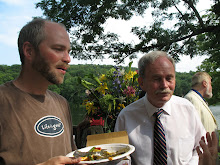The archaelogical museum is between Topkapi Palace and Hagia Sofia.
Getting into the museum proved to be a bit of an adventure as we were directed to a rough cobblestone ramp that worked its way up to a set of doors that looked olf and little-used. Right after we labored to the top of the ramp we were tolf apologetically that the doors weren't working. Dick managed the stairs up the main entrance and in we went.
Really, the museum's appeal depends on your attitude toward sarcaphogi.
I was intrigued, Dick .... Less so.
The heart of the museum is a set of sarcaphogi excavated in Sidon (Phonoecia) that were transported to Istanbul. The oldest are very Egyptian-style in blackish granite, the outer case the shape of a king with short beard.
The highlight of this part of the museum was the "Alexander Sarcaphogus" which is a rectangular casing in marble, the sides a sculpted bas relief of a battle. It must have been very colorful back in the day: a bit of color was left in some places and nearby was a wood model that suggested how vibrant and poly-chromatic it was.
The level below was full of artifacts from Hellenistic, Roman, and Byzantine periods.
Some spectacular Nicean stone pulpits told me that it did not take more than a few centuries for Catholic churches to gain their grandeur.
I also did not realize that Eastern Christianity went thru its own period where graven images were forbidden and some work of prior centuries was marred. I always thought of icons when I thought of Orthodox Christianity.
Apparently the "iconoclastic" period was started by a religious sentiment that people were worshipping the icons, not God. The similarity to Islamic belief is striking.
Sunday, March 25, 2012
Subscribe to:
Post Comments (Atom)


No comments:
Post a Comment